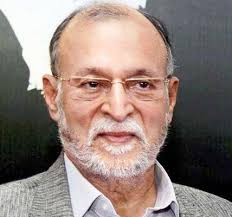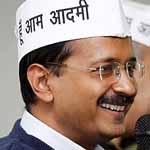Lt. Governor of Delhi
 Anil Baijal is a retired 1969 Indian Administrative Service (IAS) batch officer, who replaces Najeeb Jung as lieutenant governor of Delhi.
Anil Baijal is a retired 1969 Indian Administrative Service (IAS) batch officer, who replaces Najeeb Jung as lieutenant governor of Delhi.
An alumnus of University of East Anglia in Norwich, UK, Baijal holds a master's degree in Arts from the University of Allahabad.
As an IAS officer from the AGMUT (Arunachal Pradesh-Goa-Mizoram and Union Territory) cadre, he has served as Union Home Secretary under the Atal Bihari Vajpayee government, and is known to have removed the then I-G of Prisons Kiran Bedi for ‘breaking every clause in the jail manual.’
During his tenure as the CEO of Prasar Bharati Corporation, he had launched DD Bharati on January 26, 2002.
He was actively involved with the designing and roll-out of Rs 60,000 crore Jawaharlal Nehru National Urban Renewal Mission (JNNURM) launched by the UPA government in 2005.
In 2006, he retired from service as Secretary, Urban Development Ministry. He later served on the boards of many corporate entities such as ITC and IDFC bank.
Chief Minister of Delhi (designate)
 Arvind Kejriwal (born 16 August 1968) is an Indian politician and the Chief Minister-designate of Delhi. Born in Haryana, Kejriwal is a graduate of the Indian Institute of Technology Kharagpur, where he studied Mechanical Engineering. He worked for the Indian Revenue Service (IRS) as a Joint Commissioner in the Income Tax Department. He is well-known for his role in drafting a proposed Jan Lokpal Bill and his efforts to bring and implement the Right to Information (RTI) act at grassroots level.
Arvind Kejriwal (born 16 August 1968) is an Indian politician and the Chief Minister-designate of Delhi. Born in Haryana, Kejriwal is a graduate of the Indian Institute of Technology Kharagpur, where he studied Mechanical Engineering. He worked for the Indian Revenue Service (IRS) as a Joint Commissioner in the Income Tax Department. He is well-known for his role in drafting a proposed Jan Lokpal Bill and his efforts to bring and implement the Right to Information (RTI) act at grassroots level.
Kejriwal won the Ramon Magsaysay Award for Emergent Leadership in 2006 for his contribution to the enactment of the Right to Information Act and for his efforts to empower the poorest citizens of India. In 2006, after resigning from the IRS, he donated his Magsaysay award money as a corpus fund to found an NGO, Public Cause Research Foundation. In 2012, he launched the Aam Aadmi Party (AAP), and defeated Sheila Dixit in the 2013 Delhi Legislative Assembly election by a margin of 25,864 votes.
Early life
Kejriwal was born in the village of Siwani, Haryana, on 16 August 1968 to Gobind Ram Kejriwal and Gita Devi, a well-educated and well-off couple. He has a younger sister and brother. His father was an electrical engineer who graduated from the Birla Institute of Technology, Mesra, and whose work led to many changes in the family's residence. Kejriwal spent most of his childhood in north Indian towns such as Sonepat, Ghaziabad and Hisar. He was educated at Campus School in Hisar.
Kejriwal studied mechanical engineering at Indian Institute of Technology Kharagpur and then from 1989 he worked for Tata Steel. He left that job in 1992, having previously taken leave of absence in order to study for the Civil Services Examination, and spent some time in Kolkata, at the Ramakrishna Mission in North-East India and at Nehru Yuva Kendra.
Kejriwal joined the Indian Revenue Service in 1995 after qualifying through the Civil Services Examination. In 2000, he was granted two years' paid leave to pursue higher education on condition that upon resuming his work he would not resign from the Service for at least three years. Failure to abide by that condition would require him to repay the salary given during the leave period. He rejoined in 2003 and worked for 18 months before taking unpaid leave for 18 months.
In February 2006, he resigned from his position as a Joint Commissioner of Income Tax in New Delhi.
The Government of India claimed that Kejriwal had violated his original agreement by not working for three years. Kejriwal said that his 18 months of work and 18 months of unpaid absence amounted to the stipulated three year period during which he could not resign and that this was an attempt to malign him due to his involvement with Team Anna, a strand of the Indian anti-corruption movement. Eventually, in 2011, the matter was resolved when he paid his way out of the Service with the help of loans from friends.
Kejriwal is married to Sunita, who is also an IRS officer and his batchmate from National Academy of Administration in Mussoorie and the National Academy of Direct Taxes in Nagpur. The couple have a daughter and a son. Kejriwal is a vegetarian. He has been practicing Vipassana for many years.
About Delhi
Delhi is a city that bridges two different worlds. Old Delhi, once the capital of Islamic India, is a labyrinth of narrow lanes lined with crumbling havelis and formidable mosques. In contrast, the imperial city of New Delhi created by the British Raj is composed of spacious, tree-lined avenues and imposing government buildings. Delhi has been the seat of power for several rulers and many empires for about a millennium. Many a times the city was built, destroyed and then rebuilt here. Interestingly, a number of Delhi's rulers played a dual role, first as destroyers and then as creators.
The city's importance lies not just in its past glory as the seat of empires and magnificent monuments, but also in the rich and diverse cultures. No wonder chroniclers of Delhi culture - from Chand Bardai and Amir Khusro to present days writers - have never been at a loss for topics. In Delhi, you will discover that the city is sprinkled with dazzling gems: captivating ancient monuments, fascinating museums and art galleries, architectural wonders, a vivacious performing-arts scene, fabulous eating places and bustling markets.
Delhi has been the political hub of India. Every political activity in the country traces its roots here. This was true even of the mythological era. The Pandavas of the Mahabharata had their capital at Indraprastha, which is believed to have been geographically located in today's Delhi.
Delhi Facts
Area: 1,483 sq km
Latitudinal parallel: 28.3oN
Longitudinal meridian: 77.13oE
Altitude: 293 m above sea level
Population: 13.85million (Census 2001)
Average Temperature: 45oC (Max) - usually in May - Jun, 5oC (Min) - usually in Dec - Jan
Desirable Clothes: Woollen for winters and light cotton for summers
Rainfall: 714 mm
Monsoon: July to mid-September
Population: 13.85 (Census 2001)
Season: Extreme climate with very hot summer and very cold winter
Best time to visit: October to March
STD Code: 011
Languages: Hindi, English, Urdu and Punjabi
Religions: Hinduism, Islam, Sikhism, Buddhism, Jainism, Christianity, Zoroastrianism, Judaism and Bahai Faith
History of Delhi
Delhi, the capital of India has a strong historical background. It was ruled by some of the most powerful emperors in Indian history.
The history of the city is as old as the epic Mahabharata. The town was known as Indraprastha, where Pandavas used to live. In due course eight more cities came alive adjacent to Indraprastha: Lal Kot, Siri, Dinpanah, Quila Rai Pithora, Ferozabad, Jahanpanah, Tughlakabad and Shahjahanabad.
Delhi has been a witness to the political turmoil for over five centuries. It was ruled by the Mughals in succession to Khiljis and Tughlaqs.
In 1192 the legions of the Afghan warrior Muhammad of Ghori captured the Rajput town, and the Delhi Sultanate was established (1206). The invasion of Delhi by Timur in 1398 put an end to the sultanate; the Lodis, last of the Delhi sultans, gave way to Babur, who, after the battle of Panipat in 1526, founded the Mughal Empire. The early Mughal emperors favoured Agra as their capital, and Delhi became their permanent seat only after Shah Jahan built (1638) the walls of Old Delhi.
From Hindu Kings to Muslim Sultans, the reins of the city kept shifting from one ruler to another. The soils of the city smell of blood, sacrifices and love for the nation. The old 'Havelis' and edifices from the past stand silent but their silence also speaks volumes for their owners and people who lived here centuries back.
In the year 1803 AD, the city came under the British rule. In 1911, British shifted their capital from Calcutta to Delhi. It again became the center of all the governing activities. But, the city has the reputation of over throwing the occupants of its throne. It included the British and the current political parties that have had the honour of leading free India.
After independence in 1947, New Delhi was officially declared as the Capital of India.
The Culture of Delhi
Delhi is the traditional and present day capital of India. Delhi stands in a triangle formed by the river Yamuna in the east and spurs from the Aravali range in the west and south.
Delhi is not only the largest commercial centre in Northern India, but also the largest centre of small industries. The IT sector, handloom, fashion, textile and electronic industry contribute a lot to Delhi's economy.
Delhi is bounded by four states namely Haryana, Rajasthan, Uttar Pradesh and Punjab that have a strong influence on the lifestyle of Delhi. Delhi is a cosmopolitan city where people are open to embracing new ideas and life style. People from all parts of the country live here. Alll major festival of Inida are celebrated and the Unity in Diversity is evident in social and cultural gatherings. Be it Holi, Diwali, Id, Guru Purab, Buddha Purnima or Christmas, you will find the same vigor and bliss among people from different communities.